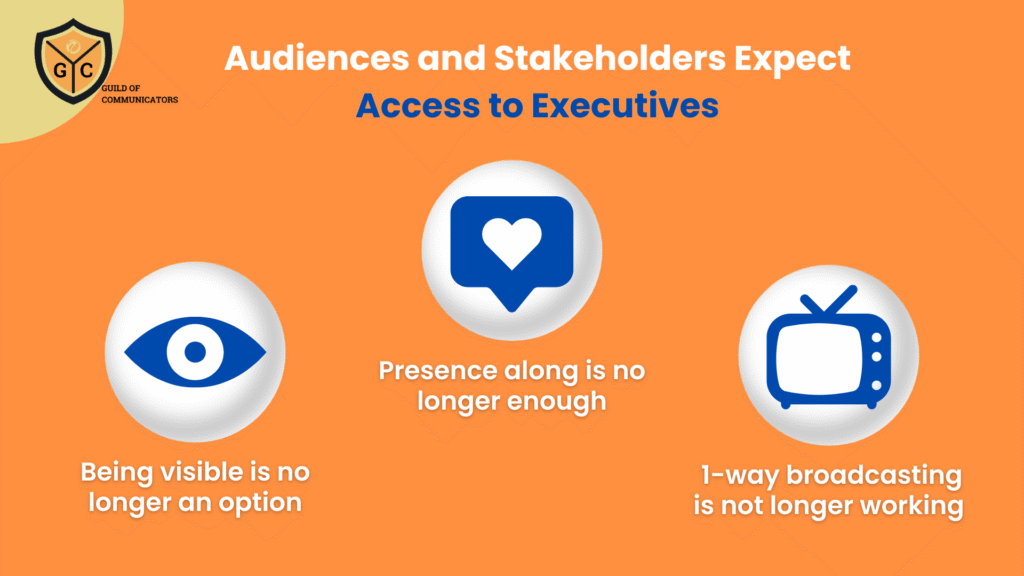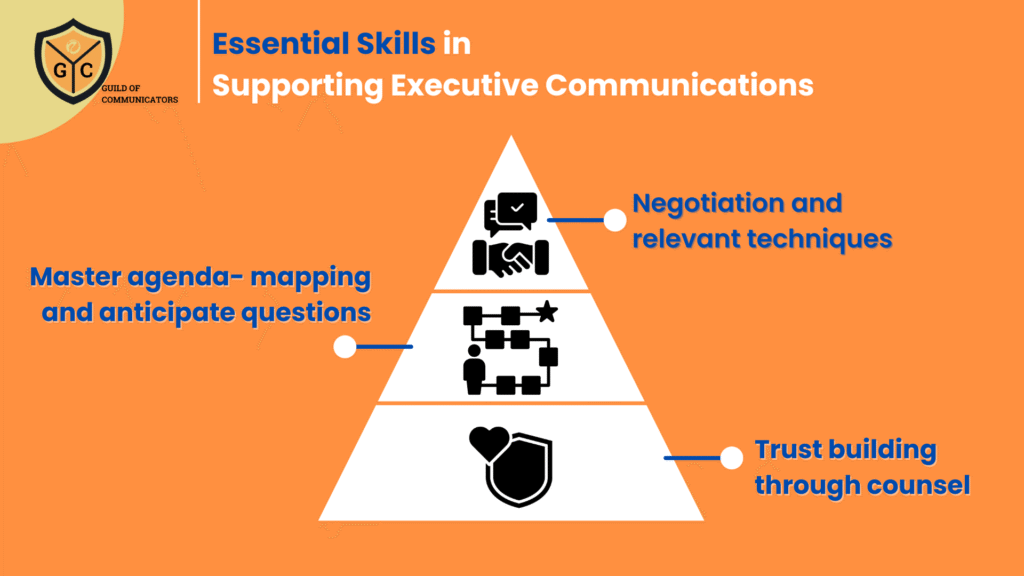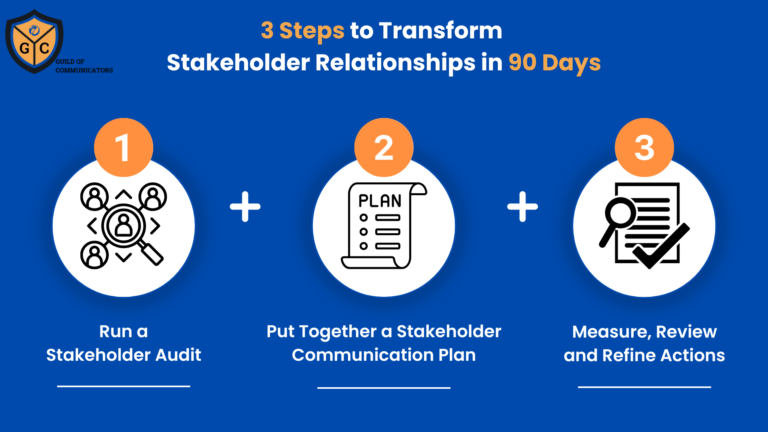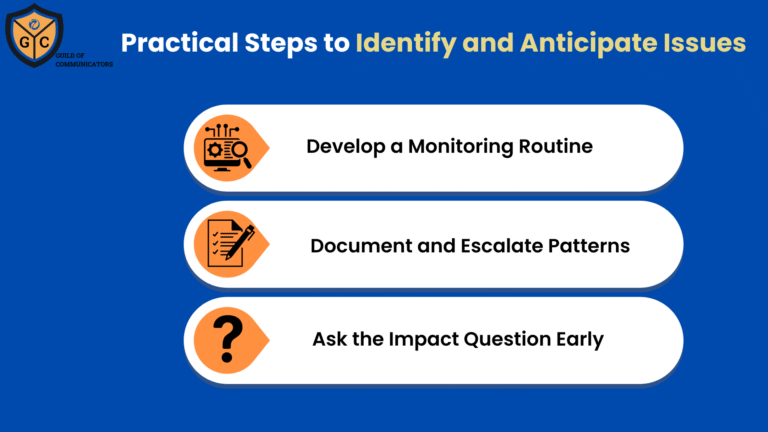Trust is a foundation-level value that businesses need to earn and maintain. It is no longer enough for organisations to talk about trust in marketing materials—it has to be seen in action.
Executive communication plays a key role in building trust and credibility. It refers to how leaders in an organisation share information and ideas—whether in writing, on screen, or at events. When done well, executive communication strengthens the organisation’s position and helps audiences see the thinking behind the brand.
One of the most effective ways to demonstrate this is by enabling senior leaders to communicate clearly, consistently, and credibly.
The End of the One-Way Message
In the past, communication was mostly one-way. Leaders made statements, and audiences were expected to listen. That model has shifted. With digital formats, cross-platform media, and interactive spaces, communication is now two-way, multidirectional, and audience-led.
Employees, customers, regulators, investors, and observers each engage on their own terms—and they often expect access to leadership views.
This shift has placed new demands on executives. Being visible is no longer optional. But presence alone is not enough. Executives need to be able to express their organisation’s value in ways that reflect real understanding of their audiences’ concerns, expectations, and questions.

The Old Playbook Is No Longer Effective
Many executives were trained under a model that no longer fits. That model focused on delivering key messages in a tightly controlled manner. Executives were trained to deliver a set of pre-approved key messages, often across multiple paragraphs in a speech or statement, and were specifically instructed not to deviate from the core topic
The idea was to project confidence, stay on-topic, and reduce risk by sharing as little as necessary. This approach was designed for an era of information control, not audience engagement
But audiences today respond differently.
A scripted delivery that avoids follow-up or context can feel out of touch or defensive.
What audiences want is not a rigid performance, but informed communication. They want to see that leaders understand the business from multiple angles—not just sales or strategy, but also product, people, and reputation. They want to hear how decisions are made, how trade-offs are considered, and how the organisation is adapting to new challenges.
The expectation is no longer for a perfectly delivered message, but for a credible and responsive conversation.
The Expectation of Cross-Functional Understanding
Authenticity is not about saying everything. It’s about showing that the leader understands what matters.
This does not mean they expect executives to share confidential information or know the answer to every granular question on the spot. It does mean they expect executives to demonstrate a broad, cross-functional understanding of the business as both an organisation and a brand.
For example, if a senior executive is announcing a new product, they should be able to speak to hardware, software, availability, pricing, sustainability, and more. Not necessarily in technical depth, but with enough clarity to show that the decision was informed by different parts of the business.
This is what makes executive communication different from general communication. It draws on the full context of the business, connects multiple domains, and is built around the idea that stakeholders will ask deeper questions.
Communicators and Executives Must Work in Partnership
Meeting these new expectations requires a shift in responsibility for both the communications team and the executive.
Communicators who support executives must gather relevant inputs, pre-empt likely questions, and help translate complex details into meaningful narratives
We must now deeply understand the wide-ranging integration of different business functions and actively gather information before and during the product or service development process, not just at the end for the press release.
This, in turn, requires the executive to prioritise and commit significant time to learn or re-learn this integrated information so they can speak about it confidently. Executives need to re-prioritise communication as a critical leadership function. This means making time to understand the issues, reviewing the available data, and identifying what can or should be shared.
Both the executive and their communicators must find effective ways to handle different cognitive loads and adjust which key messages are prioritised for which specific audiences, without losing the thread of authenticity.

Essential Skills in Supporting Executive Communications
Executive communications is not just a public relations activity. It is a leadership function.
For organisations that want to be seen as credible, responsive, and forward-looking, how their leaders show up, what they say, will continue to shape how the organisation is perceived.
The discipline of executive communications has fundamentally evolved from a function focused on message delivery to a strategic capability centered on building trust. This requires significant readjustment from both the communicators who support leaders and the executives themselves.
For communicators, it is not just about writing talking points. It requires a combination of trust-building, agenda-mapping, strategic timing, and negotiation. To support leaders effectively, communicators should develop capabilities by:
- Learning Key Negotiation Techniques. Negotiation is not just for contracts; it is crucial for aligning on messages, strategy, and time commitment with a busy executive. Familiarise yourself with foundational techniques like Principled Negotiation and BATNA (Best Alternative to a Negotiated Agreement), which focuses on finding mutual gains based on shared interests, and practice Active Listening to fully understand the executive’s perspective and concerns before offering counsel.
- Mastering Agenda-Mapping and Question Anticipation. This goes beyond predicting obvious questions. It involves deeply understanding the topic from multiple stakeholder viewpoints (e.g., an investor, an employee, a critical customer) to map out potential conversation paths. By anticipating the ‘second and third questions’ an audience might ask, you can better prepare your executive to navigate conversations with confidence and depth.
- Building Trust Through Consistent, Proactive Counsel. Trust is not built in a single briefing session. It is earned over time through reliability, proactive support, and providing counsel that proves to be sound. Consistently bring your executive well-researched insights, be direct but respectful when you identify risks, and show that you are as invested in protecting their credibility as they are.
Communicators have an important role to play in helping leaders adapt to expectations. That starts with understanding how the role of executive communications has changed, and what it now requires to be done well.
*****
Ready to elevate your communications career? The Guild of Communicators is your essential hub for professional growth, offering a vibrant community and best-in-class resources.
- Connect Membership: Ideal for early-career communicators seeking a supportive peer network, over 300 foundational and intermediate courses, and monthly interactive group sessions.
- Elevate Membership: For ambitious professionals, this tier includes premium frameworks, immersive live online workshops, dedicated career coaching, and mentorship with senior industry leaders.
Discover your path to impact and accelerated career growth.
Join the Guild of Communicators today at www.gocommunicators.com.
(For students: If you’re a student, undergraduate or postgraduate, explore our special student referral programme to lock in your membership fee for the second year! Drop us an email to find out more)
Subscribe to join over 1500+ communicators and brands getting value every Tuesday while reading A Communicator’s Perspective, our weekly newsletter.




